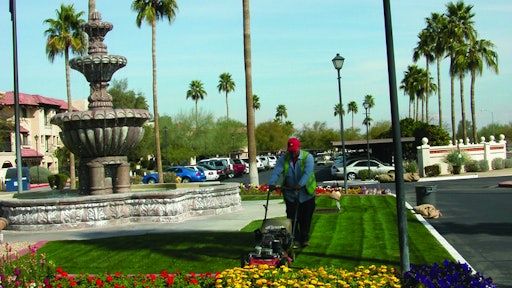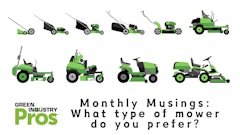
A 21-inch walk-behind lawn mower is probably not the biggest, most risky equipment investment you’re ever going to make. But if you end up making a bad one, it could come back to haunt you.
Unfortunately, many lawn maintenance contractors do—opting for less-expensive consumer-grade models while under the assumption that “it’s just a little push mower.” Downtime is downtime, though, and the failure to invest in a commercial-grade unit with increased power and durability can end up costing you money down the road.
How much more a commercial-grade 21-inch walk-behind will cost upfront can vary. For example, Ariens Company’s Gravely Pro 21 XD models typically start at $879, costing anywhere from $120 to $320 more than Gravely’s high-end consumer-grade models. Honda’s two commercial-grade models have suggested retail prices of $749 and $1,249, while the company’s high-end consumer-grade line ranges from $699 to $899.
John Deere is re-entering the commercial 21-inch walk-behind mower business this season after a five-year hiatus. “We understand that if we want to continue moving forward in the commercial business with contractors, we need to be able to offer a full breadth of product,” says Chris Russell, product manager for commercial mowing. Deere’s two new models, the WE80 and WE85, list for $1,199 and $1,299.
You Get What You Pay For
That’s a far cry from the typical $350 to $500 price tag on John Deere consumer models. But as Russell points out, you get what you pay for—and contractors must realize they are paying for durability, versatility, cut quality and uptime.
Deck and wheel construction are important, as each will take a beating day after day. “Our new machines feature a cast aluminum deck, so you don’t have to worry about any corrosion or rust,” Russell points out. “We also use a cast aluminum wheel with a replaceable rubber tread, so our wheels can take the pounding associated with pulling the mower on and off the trailer and up and over curbs.”
Features such as front bumpers and side wear strips also aid in deck durability. The depth of the cutting deck is another thing to ask your dealer about. While it doesn’t directly impact durability, it does affect cut quality.
Tom Pernice with Honda Power Equipment’s Product Planning and Marketing department says heavy-duty handlebars are an important consideration. Furthermore, an ergonomic design with easy-to-reach and use controls will make a big difference when operating the mower for extended periods.
Naturally, you want to be looking for a high-quality commercial-grade engine with both an oil filter and air filter. A commercial-grade transmission that allows the flexibility to adapt to different mowing conditions is also key. For example, Deere’s new walk-behinds feature a three-speed gear transmission for a variety of mowing speeds.
“Honda’s self-propelled mowers incorporate our exclusive hydrostatic fluid drive transmission with shaft drive,” Pernice points out. Two variable-speed transmission configurations are offered. “Smart Drive uses a paddle to adjust the speed while the mower is in operation; simply rotating the control allows increased speed. Our Cruise Control hydrostatic transmission enables users to simply pre-set the desired speed—and also allows for quick and easy speed adjustments to match exact preferences.”
This type of flexibility and versatility increases performance, as do 3-in-1 systems which allow users to mulch, bag and discharge with the same mower. Staying on the topic of cutting systems, Pernice says Honda’s MicroCut Twin Blade mulching option can eliminate clipping volume by as much as 30%. John Deere’s new walk-behind mowers feature a rear-discharge design, which allows for trimming on both sides of the machine.
The Key Is Care
Features like these make a walk-behind mower more durable, productive and comfortable to operate. But it’s up to you, the operator, to make sure this performance lasts over the long haul.
“Commercial mowers have a very long lifespan if owner/operators care for and maintain them properly,” Pernice says. “It’s not unusual for us (Honda) to hear from commercial end-users who have been faithfully using the same mower for 10, 15 or even 20 years. By adhering to the recommended maintenance schedule as outlined in the owner’s manual, the mower’s longevity can be maximized.”
“You need to be performing weekly PM (preventative maintenance),” says Tony Lapidus, Gravely’s LCS sales and demonstrator in the Chicago market. “Change the oil, grease all necessary areas, and clean or replace all filters. Then, using a high-pressure air hose, clean heads, cooling fins, shrouding and excess buildup of grass and other debris on the engine and mowing deck.”
“Keeping a sharp blade is so important,” adds John Deere’s Russell. “Contractors can sometimes go too long between sharpenings. A sharp blade allows an engine to run easier.”
That’s right—the little push mower tucked away in the corner of your trailer deserves a little tender, love and care, too. Even though it doesn’t take up as much space or cost as much as your zero-turn rider, it still plays a pivotal role in your service offering. And it may be playing an even bigger role in years to come.
“The 21-inch market might start growing more,” Russell speculates. “When you look at the trends in land development, few people are building homes with big lots, and retail spaces have lots of little grass islands. A good commercial-duty 21-inch mower provides the contractor with the right tool for the right job.”



























